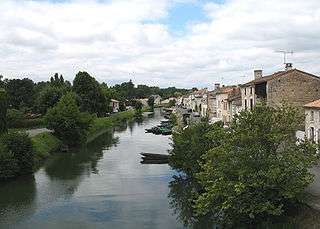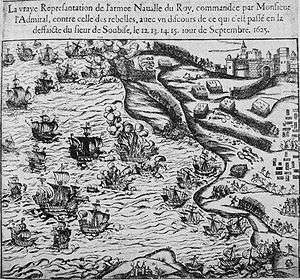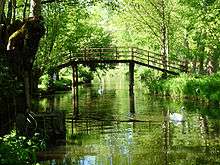Jean Hoeufft
Jean Hoeufft (Liege, 1578 - Paris, 5 September 1651) was a French banker, financier, and arms dealer, who rose through the court of Louis XIII of France to become Treasurer to Louis XIV.

Hoeufft made a fortune from his diplomatic and business ventures, ultimately becoming one of the richest men in Europe outside of the royal families.[1]
Biography
Early life and career
_-_Carte_de_Cassini.jpg)
Jan Hoeufft was born in 1578 in Liège in the Spanish Netherlands to one of the most powerful families of the United Provinces.[2] His father, a Roermond timber merchant, had moved to Aachen, Liège and Heinsberg after converting to the Reformed Church. Not much is known about Jean Hoeufft's early life.[3]:4–5 He did not marry[3]:4–5[4] and had no known children.[5][2]:85
Hoeufft eventually settled in Rouen, where there was religious freedom for Protestants for a time under Henry IV of France.[lower-alpha 1] He was naturalized in 1601.[6]:37[2]:84 He developed trade and ship owner activities trading between Spain and the United Provinces.[2]:84 From 1609 until 1616, he was deeply involved in the salt trade from Hiers-Brouage, along with his brother Dirck, based in Dordrecht. They supplied ships to the East India Company,[2] and in 1620 they commissioned a ship-of-war, to be built in Amsterdam for Charles, Duke of Guise.[7]
By 1621 Hoeufft was appointed chamberlain to Louis XIII. In the 1620s he was involved in arms trading[1] for Charles Gonzaga, Duke of Nevers. In 1628 he was allowed to collect taxes, and thus became an agent of Richelieu, who used his connections to raise money on the Dutch money market.[2]:84 In the 1630s he became a banker.[8]
Hoeufft repeatedly advanced funds to the King, and took part in major financial deals.[9] In 1634 Hoeufft participated in peace talks between the Dutch and Spain, in which Jules Mazarin and Frederick Henry, Prince of Orange were also involved. Hoeufft played a key part in diplomatic negotiations, despite having no official authority to do so.[1] His appointment as Commissioner of the States General of the Netherlands[10] was formalized in 1637.
In 1639 his house in Rouen was sacked as part of the religious wars; it is likely he moved to La Rochelle or Paris. In 1643 he obtained the fief Fontaine-le-Comte, a former lake near Sacy-le-Grand.[11]:159
Hoeufft became treasurer and Secretary to Louis XIV of France, holding those roles until his death in 1651.[12]
Arms dealer and financier

At the time of the Thirty Year's War, arms dealing was a highly lucrative business in Europe. Hoeufft, described by a contemporary as “‘a man capable of speaking and acting’ as well as ‘[having] money to distribute to people should there be need,’” was well-suited to the job.[1] Hoeufft delt with Axel Oxenstierna, Johan Adler Salvius, Hugo Grotius, Abraham de Wicquefort and Adriaen Pauw on the French support for the Swedish army; the money had to be allocated to the Amsterdam Wisselbank.
In finance, he was Cardinal Richelieu's banker for remitting subsidies during the Thirty Years War,[6]:71 and as banker to the Dukes of Saxe-Weimar, [11]:43 was charged with building financial links between the courts of France and Weimar.[2]:84
Hoeufft occupied a prominent place in the network of political interests that bound together France’s structure of alliances during the Thirty Years War. "In some sense, his political interests were so tightly interwoven with his financial and mercantile interests that they are difficult to disentangle."[13]
Hydraulic engineering

The Hoeufft family invested over a million livres in reclamation of lakes and wetlands in Picardie, Poitou and other parts of France.[14] For the most part this work was carried out between 1642 and 1653 by Dutch engineers, such as Jan van Ens.[2]
In 1650, Hoeufft was the director of the operation to drain the Poitou Marsh in western France. From the 1640s, one of his associates was David de la Croix, who married Hoeufft's niece, Marguerite Hoeufft. When Hoeufft died, de la Croix was among his beneficiaries and took over the Poitou marsh operation.[5]
Frédéric Otto Fabrice de Gressenich, Councillor and Maître d'hotel du Roi, the son of Hoeufft's sister Anne, inherited the Sacy marshes along with his Hœufft cousins. As the only cousin living in France, Fabrice administered the lands on their behalf.[11]:169
Death and legacy
Hoeufft died in Paris on 5 September 1651.[5] He had two brothers and five sisters, who by then lived in Cologne, Dordrecht, London, and Utrecht.
Hoeufft bequeathed two million livres to the poor of the Reformed Church of Charenton, near Paris.[15]
In 1736 Hoeufft's property at Petit Poitou was sold at Luçon in the Poitevin.[16]
See also
- Barthélemy Hervart – Huguenot banker
- Huguenots
Notes
- See the French Wars of Religion and Protestantism in France
References
- MACDONALD, CALEIGH. "U Of M Prof Presents On Thirty Years War The forgotten figure of Jean Hoeufft". The Manitoban. Retrieved 7 March 2017.
- Raphaël Morera (2011). "Dutch Drainage of French Wetlands". In Boomgaard, Peter; 't Hart, Marjolein (eds.). Globalization, Environmental Change, and Social History. International Review of Social History Supplements. Cambridge University Press. ISBN 1139497731.
- Thompson, Erik (16 May 2013), Jan Hoeufft and the Thirty Years War: An Essay on Diplomatic History's Limits (PDF), Umeå, Sweden: Umeå University, archived from the original (PDF) on 8 March 2017, retrieved 17 March 2017
- de Jong, Michiel (2007). "Dutch Merchants and their Interests in Finances". In Brand, Hanno; Müller, Leos (eds.). The Dynamics of Economic Culture in the North Sea and Baltic Region. Uitgeverij Verloren. ISBN 9065508821. Retrieved 2 July 2020.:234
- Nicolas Schapira (2003). Un professionnel des lettres au XVIIe siècle: Valentin Conrart, une histoire sociale [A 17th Century Man of Letters: Valentin Conarart, a Social History]. fr:Éditions Champ Vallon. p. 390. ISBN 978-2-87673-374-9. OCLC 966135435. Retrieved 16 March 2017.
- Rowlands, Guy (2015). Dangerous and Dishonest Men: The International Bankers of Louis XIV's France. Palgrave studies in the history of finance, 2015: 1. Palgrave Macmillan. doi:10.1057/9781137381798. ISBN 978-1-137-38179-8. OCLC 917173647. Retrieved 17 March 2017.
- Amsterdam City Archives, not. S. Cornelisz, (5075, 24-645), on 24 March 1620
- Raphaël Morera (2016). "Du commerce aux finances. La fortune de Jean Hoeufft (1578-1651), entre la France et les Provinces-Unies". Revue d'histoire moderne & contemporaine (in French). Belin. 63 (1): 7. doi:10.3917/rhmc.631.0007. ISBN 9782701198705.
- W.H. De Beaufort; et al., eds. (October 1891), "Vierde deel, hoofdstuk II: Hollandsche dijken op Franschen grondslag, door nl:Rudolph Peter Johann Tutein Nolthenius. (Fourth part, chap. II Dutch dikes on French territory, by R.P.J. Tutein Nolthenius)", De Gids, Fourth (in Dutch), 55th year, Amsterdam: P.N. van Kampen & zoon, archived from the original on 26 June 2013, retrieved 16 March 2017
- National Archives VII STUKKEN BETREFFENDE JAN HOEUFT EN DE LEDEN VAN HET GESLACHT HOEUFFT IN FRANKRIJK
- Hippolyte, Louis Édouard Marie, comte de Dienne (1891). Histoire du desséchement des lacs et marais en France avant 1789 (in French). Paris: H Champion. Retrieved 6 October 2018.
- DBNL
- Thomson, Erik. Jan Hoeufft and the Thirty Years War: An essay on diplomatic history's limits (PDF). Archived (PDF) from the original on 8 March 2017. Retrieved 8 March 2017.
- Thomson, Erik. "Premodern Conversations". Soundcloud. Retrieved 7 March 2017.
- Douen, Orentin (1894). La révocation de l'Édit de Nantes a Paris d'après des documents inédits (in French). 1. p. 192. Retrieved 5 October 2018.
- National Archives: VII STUKKEN BETREFFENDE JAN HOEUFT EN DE LEDEN VAN HET GESLACHT HOEUFFT IN FRANKRIJK